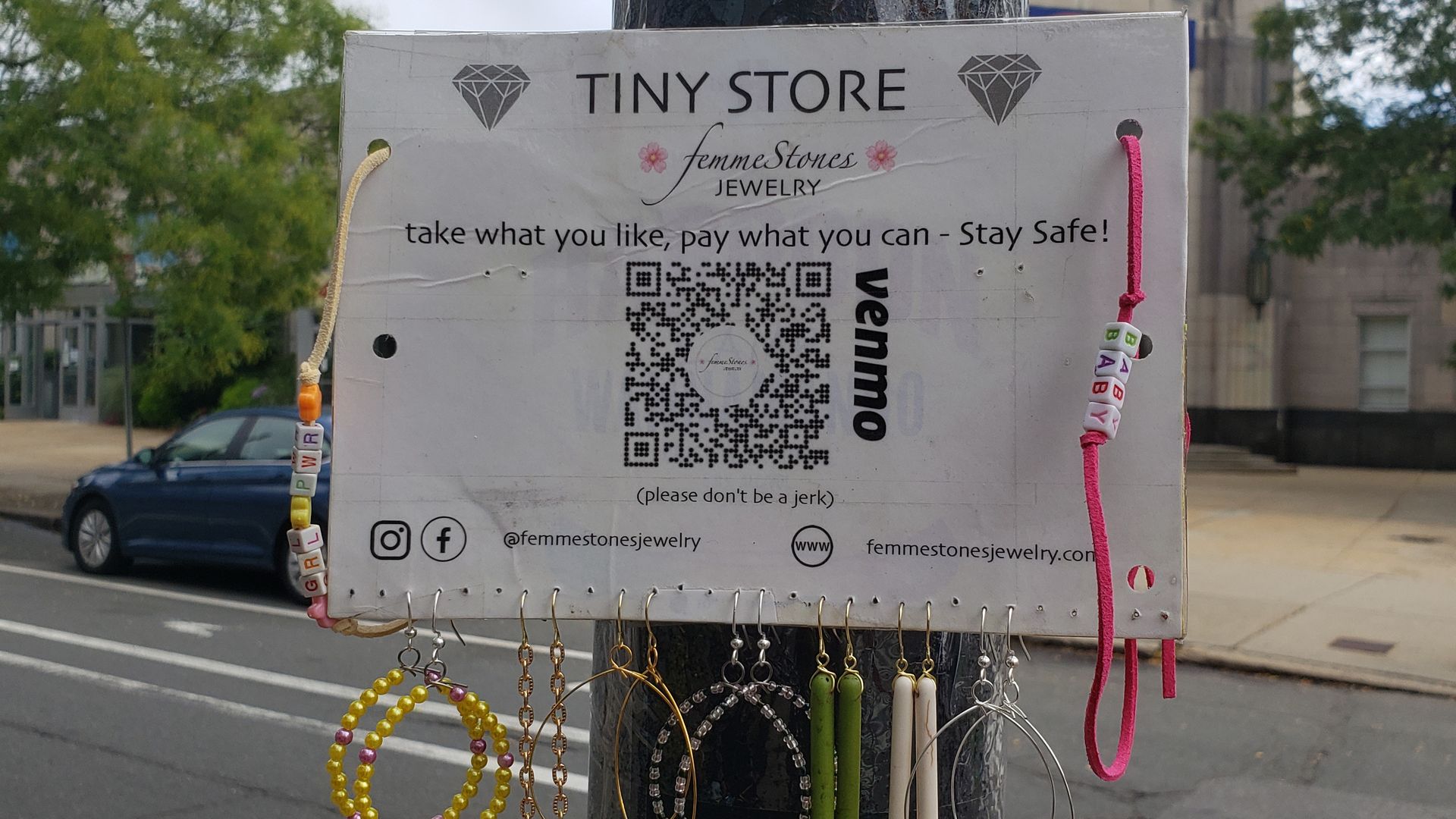| | | | | | | Presented By General Motors | | | | Axios What's Next | | By Jennifer A. Kingson, Joann Muller and Erica Pandey ·Oct 04, 2021 | | Thrift store chic — once made popular by 1960s hippies — is back with a vengeance thanks to Gen Z, who shop with carbon footprints in mind. Erica Pandey gives us the latest. - Today's What's Next photo comes from Lucy Parkinson, who shows us an honor-system form of small-scale commerce.
- Please send us your photo to whatsnext@axios.com.
Today's Smart Brevity count: 1,331 words ... 5 minutes. | | | | | | 1 big thing: Gen Z is reinvigorating thrift stores |  | | | Illustration: Annelise Capossela/Axios | | | | Gen Z shoppers are bringing about a renaissance of thrifting, Erica writes. Why it matters: The apparel and footwear industry account for about 10% of climate impact — greater than all international flights and maritime shipping trips combined. Buying clothes, shoes and more secondhand can significantly reduce fashion's carbon footprint. By the numbers: The secondhand market is projected to reach $77 billion by 2025 — up from $36 billion in 2021 — and is growing at a whopping 11 times the rate of the broader retail clothing sector, according to a report from the retail analytics firm GlobalData and the online thrift store ThredUp. The drivers of the growth are younger consumers who are drawn to thrifting for its sustainability and eclectic and cool styles. - "I've kind of stopped buying clothes from traditional stores," says Grace Snelling, a sophomore at Northwestern University. "People almost respect you if what you're wearing is thrifted, and it looks good because you've managed to pull off a cool outfit, and it's sustainable."
- Aisha Gunnell, digital director at Beacon's Closet — a chain of super cool thrift shops in Brooklyn and Manhattan — says buying secondhand made her stick out when she was in college. "In the last 10 years, it's become a lot more popular," she says.
The thrifting renaissance has hit all kinds of stores, says Adele Meyer, executive director of the National Association of Resale and Thrift Shops. Big thrift chains like Goodwill and Crossroads are seeing increased traffic, as are smaller, independent shops. - Another growing part of the secondhand market is e-commerce, as Axios' Hope King reports. Platforms like Depop (90% of users are under 26 years old) and Poshmark have helped turn young shoppers into stylists who can make a bit of income, Hope notes.
- Scores of Gen Z consumers — including Snelling — are setting up online stores to sell their stuff. And they're judiciously advertising on Instagram and TikTok, furthering the hype around thrifting even more.
But, but, but: The rise of thrifting's popularity among wealthier consumers — those who don't need the thrift to build their wardrobes — is harming lower-income shoppers, Vox reports. The surge of interest is driving prices up and depleting inventory. - Snelling says she makes sure to shop only at thrift stores in wealthier neighborhoods to make sure she's not adding to that problem.
What to watch: Gen Z's revival of secondhand fashion is a boon for brick-and-mortar retail. Even though online thrift shops are gaining popularity, younger thrifters tell me they prefer physical stores. - It's a weekend activity: Gather a group of friends and hit a string of thrift stores, digging through bins upon bins of random stuff to find the winners.
- Says Meyer, "They like the thrill of the hunt."
Share this story. |     | | | | | | 2. The science of psychedelic therapy breaks on through |  | | | Illustration: Annelise Capossela/Axios | | | | Scientific studies of psychedelic therapies may be entering a new, broader phase thanks to more interest and funding from federal governments, Alison Snyder writes in Axios Science. Why it matters: MDMA, psilocybin and LSD — combined with psychotherapy — have shown promise for treating a range of addictions and mental health disorders, including treatment-resistant depression and PTSD. - Mental health and substance use disorders take lives and cost money — directly for treating the disorders and indirectly in productivity. Efforts to find new treatments have come up short, leading to a decline in investment in developing new drugs.
- The big dollars that come with funding from science agencies like the National Institutes of Health could allow researchers to study nitty-gritty details — about dosing and other variables — needed for a drug to become an accepted part of medical practice.
- Public funding could also allow trials of psychedelic therapies to be larger and more diverse, as well as independently evaluated.
The long, strange trip: The therapeutic benefits of psilocybin and LSD were studied in the 1950s and 1960s. - But that research largely stopped in 1970 for a combination of reasons, including concerns about recreational use of the drugs.
- About 20 years ago, there was a resurgence in studying psychedelics in humans, but the research has largely been backed by private philanthropists.
- That's partly because studies struggled to meet best scientific practices, like randomizing trials and having a placebo control, says Steven Grant, a former program officer at the National Institute on Drug Abuse (NIDA) who is now director of research at Heffter Research Institute, which promotes the scientific study of classic psychedelics, like psilocybin.
- There also weren't companies lining up to take the drugs and further develop them.
Where it stands: Philanthropists have funded pilot studies about psychedelic therapies, and a recent boom in biotech companies pursuing them indicates the treatments could have a path to market. Read the full story. |     | | | | | | 3. The market value of various college degrees |  Reproduced from Bankrate. Table: Axios Visuals Not surprisingly, STEM degrees give college graduates access to more plentiful and lucrative jobs than do liberal arts and other majors, according to a Bankrate.com survey, as Jennifer writes. Methodology: Bankrate.com sought to determine the most and least "valuable" majors by evaluating the most recent data available from the U.S. Census Bureau's American Community Survey, looking at the 159 majors reported by at least 250 people in the 2019 survey. - The company looked at three factors: median income (weighted at 70% of the result), unemployment rate (20%) and the percentage of people with an advanced degree (10%).
What they found: Graduates of the No. 1 "most valuable" major, architectural engineering, earn a median annual salary of $90,000 and enjoy a low unemployment rate (1.3%). - The percentage of architectural engineering majors with an advanced degree is relatively low — 29.3% — meaning they are less likely than others to have to shell out for an advanced degree.
- In the "least valuable" major — visual and performing arts — the median salary is $35,500, the unemployment rate is 3.6%, and 28.7% have an additional degree.
Why it matters: Choosing a school and a major is a huge financial decision, so students and their families should be aware of the market value of what they're buying, Bankrate.com argues. |     | | | | | | A message from General Motors | | See our vision for the future in focus at GM Investor Event 2021 | | |  | | | | To realize our vision of a world with zero crashes, zero emissions and zero congestion, General Motors is scaling the power of our hardware and software to redefine experiences and services. This is how our platforms will change everything. | | | | | | 4. The end of vice |  | | | Illustration: Annelise Capossela/Axios | | | | A wave of decriminalization and legalization has changed how the police and society approach vice crimes, Bryan Walsh writes in Axios Future. Why it matters: The move shows growing social tolerance of activities like gambling, sex work and recreational drug use, and a desire to pull back on prosecuting what can be classified as "victimless crimes." - But just because vices may lack an identifiable victim doesn't mean that tolerating them won't have unpredictable and potentially negative social consequences.
What's happening: When the NFL season began last month, fans in more than two dozen states and the District of Columbia were legally allowed to place bets on games, up from 18 jurisdictions at the start of last season. Five more states are projected to allow it by the end of the year, according to the American Gaming Association (AGA). - In April, the Manhattan district attorney's office announced it would stop prosecuting sex work and unlicensed massage, joining a number of other jurisdictions that have moved to partially decriminalize sex work.
- Last November, after the passage of a ballot initiative, Oregon became the first state to decriminalize possession of small amounts of all illicit drugs, while four more states — Arizona, New Jersey, South Dakota and Montana — joined the 11 others that have legalized the recreational use of cannabis.
The big picture: What this amounts to is an under-the-radar shift in how society treats what have long been thought of as "vice crimes" — behavior that might not actively harm anyone not voluntarily involved in the activity but are considered to offend social morals. The bottom line: 50 years after President Richard Nixon declared the "war on drugs," American attitudes toward and laws about activities that have long been classified as vices are changing — as is the assumption that it's the government's role to police public morality. Read the full story. |     | | | | | | 5. Reader photo of the day |  | | | Photo: Lucy Parkinson | | | | What's Next: Proprietor-free crafts vendors Lucy Parkinson writes: "Some innovative commerce in Somerville, Massachusetts — a Venmo store pinned to a traffic light." |     | | | | | | A message from General Motors | | See our vision for the future in focus at GM Investor Event 2021 | | |  | | | | To realize our vision of a world with zero crashes, zero emissions and zero congestion, General Motors is scaling the power of our hardware and software to redefine experiences and services. This is how our platforms will change everything. | | | | Welcome to October! Do your leaf-raking neighbors subscribe to Axios What's Next? Feel free to send them the signup link when they come to borrow your tools. |  | | It'll help you deliver employee communications more effectively. | | | | | | Axios thanks our partners for supporting our newsletters. If you're interested in advertising, learn more here.
Sponsorship has no influence on editorial content. Axios, 3100 Clarendon Blvd, Suite 1300, Arlington VA 22201 | | | You received this email because you signed up for newsletters from Axios.
Change your preferences or unsubscribe here. | | | Was this email forwarded to you?
Sign up now to get Axios in your inbox. | | | | Follow Axios on social media:    | | | | | |









No comments:
Post a Comment